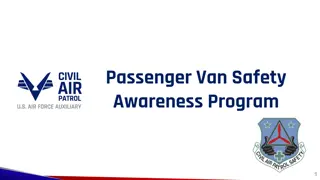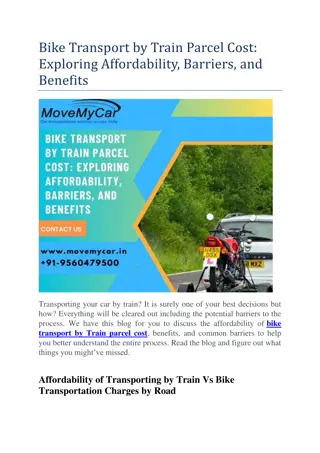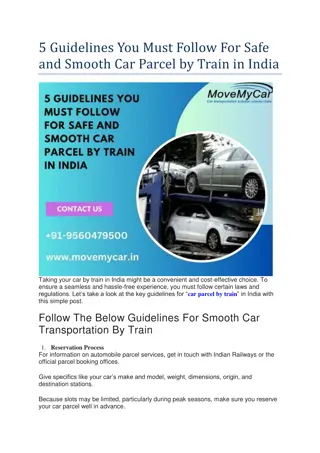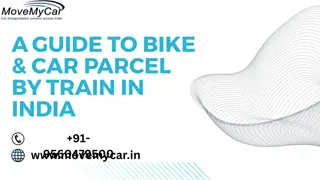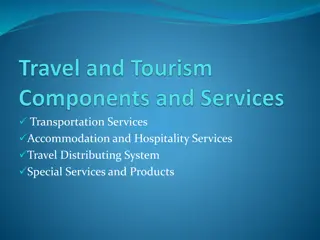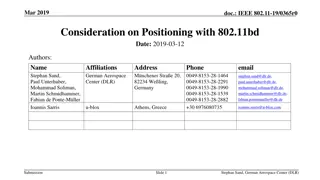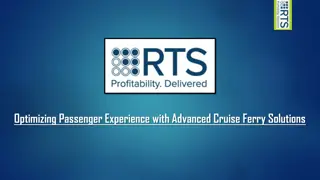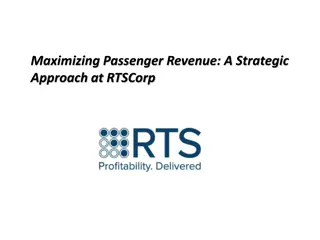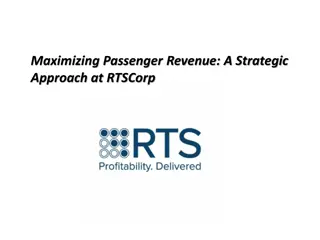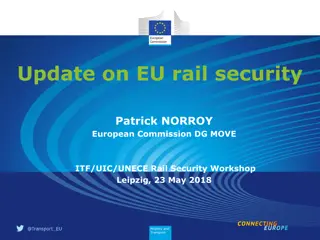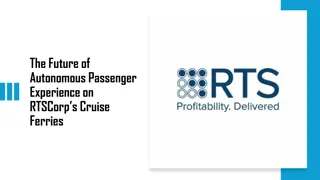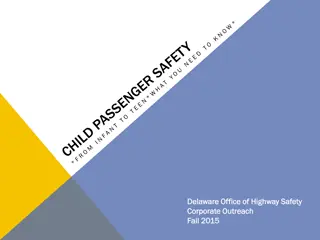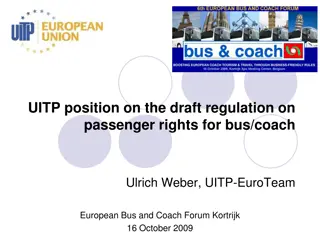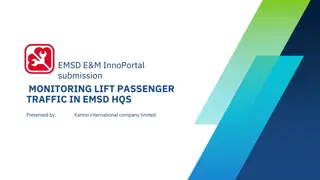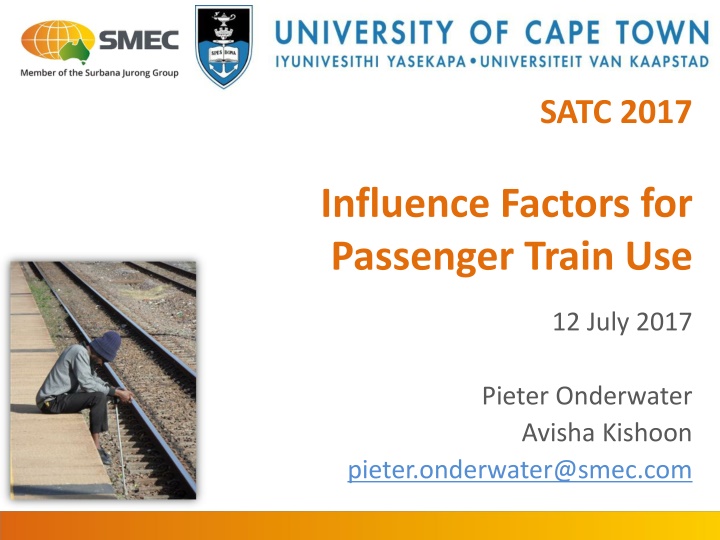
Understanding Factors Influencing Passenger Train Use
This research explores the influence factors affecting passenger train use, focusing on socio-economic aspects, train system characteristics, and other transportation system factors. The study delves into the elasticity of demand in response to variables like price and time, highlighting the intricate relationships between different parameters. The analysis covers various aspects such as population, jobs, economic growth, car ownership, fare prices, travel time, comfort, and capacity constraints. Additionally, it touches upon the impact of fuel prices, toll and parking costs, congestion, and other public transportation services on train demand.
Download Presentation

Please find below an Image/Link to download the presentation.
The content on the website is provided AS IS for your information and personal use only. It may not be sold, licensed, or shared on other websites without obtaining consent from the author. If you encounter any issues during the download, it is possible that the publisher has removed the file from their server.
You are allowed to download the files provided on this website for personal or commercial use, subject to the condition that they are used lawfully. All files are the property of their respective owners.
The content on the website is provided AS IS for your information and personal use only. It may not be sold, licensed, or shared on other websites without obtaining consent from the author.
E N D
Presentation Transcript
SATC 2017 Influence Factors for Passenger Train Use 12 July 2017 Pieter Onderwater Avisha Kishoon pieter.onderwater@smec.com
Presentation Outline Introduction Background Methodology Elasticities Influence parameters Results Socio-economic Train system Other transportation systems Summary and conclusion
Background Influence Factors for Passenger Train use. PhD study on PT/Rail Planning (at UCT) PT passenger demand planning parameters, for: 2 types of passengers: 2 types of PT Train systems: by Pieter Onderwater Captives, and Choice Users PRASA Metrorail, and Gautrain This paper has the first (qualitative) result of: Concept frameworks and analyses Scientific (international) literature study Future developments, impacting on Train use (draft) parameters To be continued
Methodology Elasticity = % change in demand, in response to 1 % change in a variable Price, Time Mostly Negative = increase in price decrease in demand Mainly Inelastic = elasticity < (+/-) 1 Wide variety = personal, trip purpose, etc. Cross-Elasticity: impact by variables of other Transportation systems Elasticity of other mode * substitution (mode share, diversion) Mostly Positive, very Inelastic, location specific range / average no set value Elasticity Price Time Trip budgets : Money Time Effort (physical, mental) (Value of Time (Willingness to Pay, Subjective time) Generalised Costs)
Influence parameters Public Transport / Train demand depends on: Socio-Economic aspects Population, jobs, economic growth, car-ownership Train system aspects Fare price, travel time, comfort, capacity constraints Other Transportation systems aspects Fuel price toll and parking costs, congestion, other PT s LoS
1. Socio-Economic aspects Population and Jobs 1. Study area average: Socio growth Economic growth Determinative aspect: Population (real) GDP / capita 2. Study area specific: Variation per station area Train Peak travel = Commuters Off-Peak travel = Social, Leisure, etc. Per group: Captives, Choice Users Airport train service (e.g. Gautrain) Determinative row/column in OD: Jobs (= GDP) Population Car-ownership (=GDP) Airport pax (= GDP) Elasticity = + 1 (plus other aspects / impacts) Average annual Mobility growth = 3 % Be aware of double counting local variations
2. Train system Fare price Captives are more price sensitive, compared to Choice Users However, Captives have less alternatives Low Price-Elasticity for making a PT trip High Price-Elasticity between PT modes (train, bus, minibus-taxi) Off-Peak, Weekend / Social, Leisure travellers are more price sensitive, compared to Peak / Commuters Generally factor 1 - 2 higher Airport trips are less price sensitive walk, or not travel Price Elasticity = between 0.1 and 1.0 (generally: 0.3 to 0.6) No impact PT fares normally increase in line with CPI (5-6 %)
Train system Trip Time and Frequency Choice Users are more time sensitive, compared to Captives Time is Money Peak / Commuters are more time sensitive, compared to Off-Peak, Weekend / Social, Leisure travellers Airport trips are more time sensitive (stress, delays) Time Elasticity = between 0.4 and 0.9 No impact Trip time of train service is mostly constant Unless serious improvements (e.g. PRASA Modernisation) Frequency increase reducing waiting time Little impact + 1 to 2 % more Train use, once-off Unless crowding higher freq = more capacity = more comfort small changes (few minutes)
Train system Effort: convenience, comfort Choice Users are more effort sensitive, compared to Captives They have a (convenient / comfortable) alternative car But very difficult to quantify Safety (subjective) Traditional PT is deemed not to be safe hardly used by Choice Users Discomfort due to crowding little Standing passengers: subjective time = * 1.5, Seated passengers: subjective time = * 1.0, Insufficient capacity: people left behind on the platform extreme increasing to * 2.0 increasing to * 1.6 This will reduce / cap the potential growth Comfortable access, waiting time at station Subjective time = * 1.2 to 3.0 (average: * 2)
Train system Capacity Constraints Station Accessibility Quality of public realm: Local congestion: impacts on drop-off/pick-up, Parking, PT feeders, etc. impacts on walking, PT ranks Station Parking (Choice Users only) At specific stations only Capacity Restrictions at the end of AM peak and in off-peak No constraints in weekends This will reduce / cap the potential growth
3. Car/Road system Fuel Price Off-Peak, Weekend / Social, Leisure travellers are more price sensitive, compared to Peak / Commuters similar for cross-elasticity Generally factor 1 - 2 higher Impact on: Choice Users car costs Captives PT costs (relatively smaller impact) Price Cross Elasticity = + 0.1 to + 0.4 (varies widely: local circumstances) Fuel Price determined by Crude Oil and Dollar Exchange Expected annual increase = CPI + 5 % highly volatile: + 1 to + 2 % more Train use = *
Car/Road system Toll and Parking For Choice Users mainly: E-toll in Peak has limited impact: Applicable on limited roads Capped at R225/month = R5 per trip for regular motorists Full price Non-Compliance Parking costs has limited impact: Commuters (Peak) parking on employers premises Social (Off-Peak) limited destinations: full payment, but limited time Off-Peak: more impact Price Cross Elasticity = + 0.0x Relatively small portion of total car travel costs No impact Other car costs normally increase in line with CPI (5-6 %)
Car/Road system Congestion Peak traffic is congested Off-Peak traffic is hardly congested (yet) Impact on: Choice Users Captives car travel time road based PT time shift to Gautrain not really to other PT shift to Metrorail Time Cross Elasticity = + 0.4 (varies widely: local circumstances) Peak Congestion might increase with > 4% annually + 1 to + 2 % more Train use Depending on socio-economic developments
Summary PT / Train patronage depends on: Socio-Economic Rail patronage Annual growth: + 3 % average Population / Jobs growth Train system Fare price Trip time, frequency Other quality improvements Capacity constraints 0 + 1 to + 2 % (once-off) + Growth Capped growth Other Transp. systems Fuel price + 1 to + 2 % + 0 + 1 to + 2 % e-toll, parking costs Congestion Total annual average (+/ local circumstances) + 5 to 6 % ( Capped)
Conclusions So far, the elasticity parameters are based on international scientific literature: My PhD study will further investigate the SA context Revealed and Stated Preference studies for Gautrain and PRASA Metrorail Train demand can potentially grow with some 5% annually: Half the impact by socio-economic growth (population, jobs, GDP) Half the impact by road system (fuel price, congestion) Once-off impacts by Train system improvements (e.g. PRASA Modernisation) However, current Train systems are restricted by their capacity Rolling Stock capacity = crowding, low freq. Parking capacity, station accessibility Programmes in place to increase capacity: New Rolling stock Gautrain, PRASA PRASA Modernisation Questions?: pieter.onderwater@smec.com reduced growth

